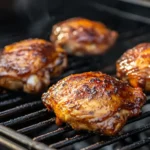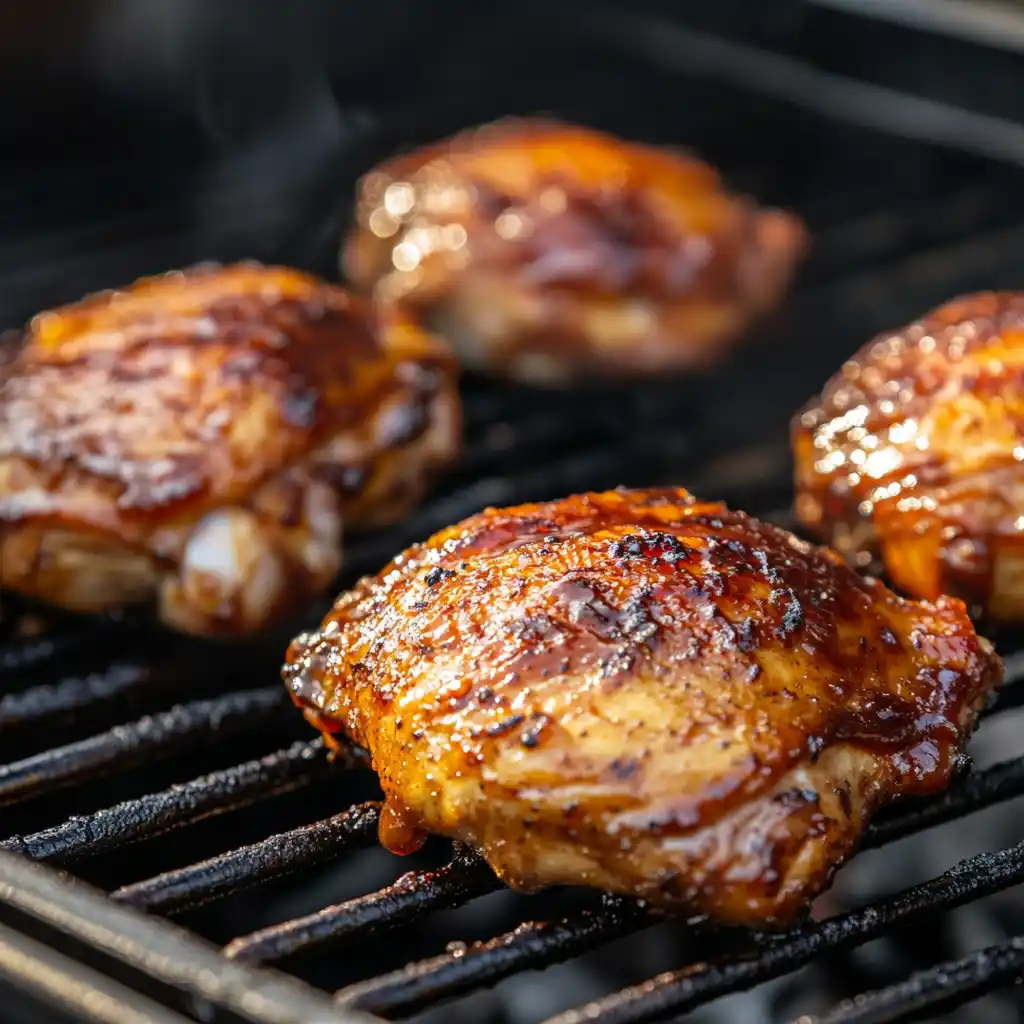New to grilling and wondering where to start? Traeger recipes make it easy to create smoky, delicious meals even if you’ve never smoked a piece of meat in your life. In this beginner-friendly guide, you’ll learn essential tips, tools, and foolproof dishes to master wood-fired cooking with confidence. Ready to turn your backyard into a BBQ paradise? Let’s fire it up!
Table of Contents
Why Traeger Grills Are Perfect for Beginner Smokers
If you’re new to backyard smoking, Traeger grills are like the friendly mentors of the BBQ world. They take out most of the guesswork and make the smoking process easy even if you’ve never touched a grill before. Why? Because they combine the flavor magic of wood smoke with the simplicity of set-it-and-forget-it tech.
What Makes Traeger Grills Unique Compared to Others
Traditional charcoal smokers can feel intimidating, right? You’ve got to babysit the fire, manage air vents, and hope your meat doesn’t end up tasting like an ashtray. Traeger grills flip the script. They use wood pellets as fuel and an automatic auger to feed those pellets into the fire pot, keeping a consistent temperature throughout the cook.
This pellet-powered system gives you precise control, just like an oven. But instead of electric heat, you’re infusing your food with real, wood-fired flavor. No more swinging temperatures or guessing if your coals are hot enough.
Key Features That Help Beginners Master Smoking
Here are a few features that make Traeger a beginner’s best friend:
- Digital Temperature Control: Set your temp and let the grill do the work.
- WiFIRE Technology: Control your grill from your phone (yes, really).
- Versatility: Smoke, grill, roast, bake, braise all in one unit.
- Consistent Results: Even heat across the cooking surface means fewer surprises.
Traeger’s design helps you avoid the common “BBQ disasters” that scare off newbies. It’s like training wheels for smoking meat—and you’ll be off and riding solo in no time.
Getting Started: Must-Have Tools for Traeger Recipes
Before you throw on your first rack of ribs, let’s gear up. Think of this like packing your backpack before a school trip. The right tools make all the difference between a smooth ride and a smoky mess.
Top Essential Accessories Every Traeger Cook Needs
Not all accessories are must-haves, but some are true game-changers for your first few cooks. Here’s what you should start with:
- Meat Thermometer: Internal temp = success. Don’t guess know when it’s done.
- Grill Cover: Protect your investment from rain, dust, and squirrels.
- Drip Tray Liners: Keep cleanup simple. Just toss and replace.
- Grill Tongs & Spatula: Choose sturdy tools with long handles.
Want to level up? Look into a pellet storage bin or a magnetic side shelf. Handy extras like these help you stay organized and efficient.
Choosing the Right Wood Pellets for Flavor and Heat
Wood pellets aren’t just fuel they’re flavor bombs waiting to explode (in a good way). Different woods add different tastes, and your choice will shape your entire dish.
| Pellet Type | Best For | Flavor Profile |
|---|---|---|
| Hickory | Pork, Beef | Strong, smoky, classic BBQ flavor |
| Apple | Chicken, Fish | Slightly sweet, mild smoke |
| Mesquite | Red meat, Brisket | Bold, earthy, intense |
| Maple | Vegetables, Poultry | Sweet, subtle, caramel-like |
You don’t need to stick to just one type. Try blending pellets to make your own signature flavor combo!
Common Beginner Mistakes with Traeger Recipes
Starting something new means making a few mistakes—totally normal! But let’s save you some headaches (and wasted meat) by calling out the biggest missteps beginners make on a Traeger.
Over-Smoking or Under-Cooking: How to Avoid It
Some folks think more smoke = more flavor. But too much smoke can turn your meat bitter. If your food tastes like a burnt campfire, you’ve gone too far.
On the flip side, undercooking is another rookie mistake. Not hitting the right internal temps can leave food unsafe or just plain chewy.
“Cooking with smoke is like using perfume too much can ruin the experience.” Pitmaster Kevin L.
Use your meat thermometer religiously, and remember: low and slow wins the flavor race.
Temperature Control Challenges and How to Fix Them
Pellet grills usually maintain temp well, but outdoor factors like wind or cold weather can cause swings. If your Traeger keeps jumping between temps, try these tips:
- Close the lid quickly after checking food to keep heat in.
- Use a grill blanket in cold climates.
- Check for ash buildup in the fire pot (it can mess with combustion).
Want a dish that’s virtually fail-proof for first-timers? Try this smoked queso recipe that delivers bold flavor with almost zero effort.
Traeger Cooking Basics: From Prep to Plate
Think of this section as your cheat sheet. Once you’ve got these basics down, everything else becomes easier (and tastier).
How to Preheat, Smoke, and Finish Your First Dish
Here’s the general flow you’ll follow for nearly every Traeger recipe:
- Preheat the grill: Always start with a hot grill. Set your temp, close the lid, and let it heat for about 10–15 minutes.
- Prepare your meat or veggies: Season generously with your chosen rub or marinade.
- Place on grill grates: Keep space between items for better airflow.
- Monitor internal temp: Use your thermometer and aim for target temps (more on that next).
- Rest your meat: Don’t skip this! Resting helps juices redistribute.
Looking for a smart way to plan your dinner? Check out these easy dinner ideas to spark your next BBQ session.
Internal Temperatures to Know for Perfect Results
Don’t wing it these internal temps ensure safety and taste:
| Meat Type | Target Internal Temp |
|---|---|
| Chicken (Breasts/Thighs) | 165°F |
| Pork Shoulder | 195–205°F (for pulling) |
| Beef Brisket | 200–205°F |
| Salmon | 145°F |
| Ground Beef (Burgers) | 160°F |
5 Foolproof Traeger Recipes for Total Beginners
Let’s get cooking! These beginner-friendly recipes are low-stress, high-reward, and packed with wood-fired flavor.
Simple Swaps for Low-Carb or Gluten-Free Diets
BBQ doesn’t have to mean carb overload. You can still enjoy smoky goodness without the bread or sugar.
- Use sugar-free rubs: Many store-bought blends have hidden sugars make your own or check the label.
- Skip the buns: Serve pulled pork in lettuce wraps or over a salad.
- Gluten-free BBQ sauce: Opt for brands that clearly state “GF” or use tamari instead of soy sauce in marinades.
For something lighter but still hearty, this quinoa and black bean salad makes a fantastic side dish or base for smoked chicken.
Where to Find the Best Traeger Recipes Online and Offline
Need more inspiration? There are tons of great places to expand your recipe library:
- Traeger App: Filled with hundreds of recipes tailored to your grill model.
- BBQ YouTube Channels: Visual guides are super helpful for timing and technique.
- Cookbooks: Look for titles like “The Traeger Grill Bible” or “Smoking Meat 101.”
- Trusted food blogs: Browse our ultimate Traeger recipe guide for next-level meals and smoking tips.
FAQ
1. What makes Traeger recipes ideal for beginners?
Traeger grills offer digital temperature control and consistent heat, making it easy for beginners to smoke food without constant monitoring or guesswork.
2. What’s the easiest meat to start with on a Traeger?
Chicken thighs and pork shoulder are great beginner options they’re forgiving, juicy, and soak up smoky flavors beautifully.
3. Do I need to preheat my Traeger grill before cooking?
Yes, always preheat your Traeger for 10–15 minutes to ensure even cooking and proper smoke flow from the start.
4. What temperature should I use for most Traeger recipes?
Most smoking recipes start around 225°F. It’s the perfect low-and-slow temp to infuse flavor without drying out your food.
Mastering Traeger recipes doesn’t require years of grilling experience just the right tools, guidance, and a little smoke. From juicy chicken to flavor-packed veggies, even beginners can create mouthwatering meals with ease. Ready to take your outdoor cooking to the next level? Share your first Traeger success story in the comments or explore more Traeger recipes to keep the fire going!
Print
Smoked BBQ Chicken Thighs on the Traeger
- Total Time: 2 hours 10 minutes
- Yield: Serves 4
- Diet: Gluten Free
Description
Juicy on the inside, crispy on the outside, these Traeger recipes for BBQ chicken thighs are perfect for anyone just starting with their smoker. Infused with sweet, smoky flavor from applewood pellets and coated in a sticky BBQ glaze, this dish is a guaranteed crowd-pleaser. Whether you’re cooking for a weeknight dinner or a backyard cookout, these thighs deliver bold taste with minimal effort.
Ingredients
6 bone-in, skin-on chicken thighs
2 tablespoons olive oil
3 tablespoons brown sugar
2 teaspoons smoked paprika
1 teaspoon garlic powder
1 teaspoon onion powder
1 teaspoon kosher salt
½ teaspoon black pepper
1 cup BBQ sauce (choose your favorite – sweet, spicy, or smoky)
Applewood or hickory wood pellets
Instructions
Step 1: Prep the chicken
Pat the chicken thighs dry with paper towels. This helps the skin crisp up during cooking. Drizzle with olive oil and rub it in evenly.
Step 2: Mix the dry rub
In a small bowl, combine the brown sugar, smoked paprika, garlic powder, onion powder, salt, and pepper. Sprinkle the dry rub generously over both sides of each thigh, pressing it in gently.
Step 3: Preheat your Traeger grill
Turn your Traeger grill on and set the temperature to 225°F. Allow it to preheat with the lid closed for about 15 minutes. Make sure the hopper is full of applewood or hickory pellets for that delicious smoky flavor.
Step 4: Smoke the chicken
Place the chicken thighs skin side up on the grill grates. Smoke at 225°F for 1.5 to 2 hours, or until the internal temperature reaches 160°F.
Step 5: Glaze and finish
Brush a thick layer of BBQ sauce on the chicken. Increase the grill temperature to 375°F and cook for another 10–15 minutes until the sauce caramelizes and the internal temperature hits 175°F.
Step 6: Rest and serve
Remove the chicken from the grill and let it rest for 5–10 minutes before serving. This helps the juices redistribute for maximum tenderness.
Notes
Don’t skip the rest time! It’s crucial for juicy chicken.
You can use boneless thighs, but they cook faster check doneness around 35 minutes total.
For spicier flavor, add cayenne pepper or a dash of hot sauce to the BBQ glaze.
Try different wood pellets like mesquite or cherry for a flavor twist.
- Prep Time: 10 minutes
- Cook Time: 2 hours
- Category: Main Course
- Method: Smoking / Grilling
- Cuisine: American
Nutrition
- Calories: 320
- Protein: 25g
- Cholesterol: 120mg

